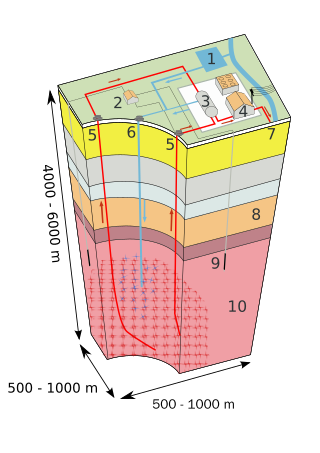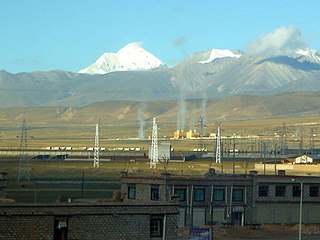
Rosemanowes Quarry, near Penryn, Cornwall, England, was a granite quarry and the site of an early experiment in extracting geothermal energy from the earth using hot dry rock (HDR) technology.

Rosemanowes Quarry, near Penryn, Cornwall, England, was a granite quarry and the site of an early experiment in extracting geothermal energy from the earth using hot dry rock (HDR) technology.
In the nineteenth century the quarry provided stone for building projects in Britain and abroad as well as for the Ponsanooth viaduct near Penryn and the Carnon Valley viaduct between Truro and Falmouth. [1]
The site was chosen as the research site because the granite in the area has the highest heat flow in England (120 milliwatts per square metre). [2] The trials began in 1977 in the wake of the 1973 oil crisis and an earlier trial in the United States at Fenton Hill. The trials at Rosemanowes concluded in 1980, although studies continued until 1991. [3] Funding for the initial project was provided by the Department of Energy (now the Department of Trade and Industry) and by the European Commission. [4] The research facilities and staff transferred to Camborne School of Mines Associates Limited in 1992, the trading arm of the Camborne School of Mines. The project had two aims
With government and EU support the expertise of the scientists and engineers at Rosemanowes was used to support the European HDR project at Soultz-sous-Forêts, [5] and a number of commercial contracts ensued exploiting HDR techniques, such as microseismic monitoring, in the oil and gas industry. Rosemanowes Quarry and the assets of CSMA, including intellectual property, were acquired by Asea Brown Boveri in 1997. In 2004, Schlumberger acquired the intellectual property and some of the staff most closely associated with microseismic monitoring and the quarry was sold off.



In 2006, the site was acquired by 3K Facilities. [6] The company now offers deep borehole test facilities in one of the best-logged sites in the world. All the deep boreholes are now available to hire for a range of down hole testing. There are three deep boreholes (2,350 m (7,710 ft), 2,180 m (7,150 ft), 2,800 m (9,200 ft)), four uncased 300 m (980 ft) holes and one 150 m (490 ft) hole inclined at 30 degrees, as well as micro seismic testing and a wind turbine test environment on this 20 acres (81,000 m2) site.
Although the energy has not yet been exploited commercially, the data provided by the tests has been widely used to test numerical simulation codes. [7] [8] The dataset contributed significantly to the geothermal power plant built with European Union sponsorship at Soultz-sous-Forêts. [8] [9] [10]
In March 2013, the quarry was put up for sale by the owners 3K Facilities. [1]
In February 2014 Rosemanowes Quarry was purchased by Avalon Sciences (a Somerset-based borehole seismic instrumentation company) with the intention to develop the site in to an industry leading facility for testing down hole seismic and logging instrumentation. The extensively characterised boreholes and wells within homogenous granite facilitates an ideal locality to prove down hole seismic receivers and sources, all extensively used within the oil and gas exploration and monitoring industries. This site will be available for use to both industry and academic institutions by the end of 2014/early 2015.
During the Second World War, the Quarry was used for storage by US forces, preparing for the invasion of Europe, which started in June 1944. [11]
The quarry is at Herniss, to the north of the A 394 road, between Rame and Longdowns. Ordnance Survey, Explorer series, Map 103, : grid reference SW73453460 .

Geothermal energy is thermal energy in the Earth's crust. It combines energy from the formation of the planet and from radioactive decay. Geothermal energy has been exploited as a source of heat and/or electric power for millennia.

A borehole is a narrow shaft bored in the ground, either vertically or horizontally. A borehole may be constructed for many different purposes, including the extraction of water, other liquids, or gases. It may also be part of a geotechnical investigation, environmental site assessment, mineral exploration, temperature measurement, as a pilot hole for installing piers or underground utilities, for geothermal installations, or for underground storage of unwanted substances, e.g. in carbon capture and storage.

The Kola Superdeep BoreholeSG-3 is the result of a scientific drilling project of the Soviet Union in the Pechengsky District, near the Russian border with Norway, on the Kola Peninsula. The project attempted to drill as deep as possible into the Earth's crust.
Induced seismicity is typically earthquakes and tremors that are caused by human activity that alters the stresses and strains on Earth's crust. Most induced seismicity is of a low magnitude. A few sites regularly have larger quakes, such as The Geysers geothermal plant in California which averaged two M4 events and 15 M3 events every year from 2004 to 2009. The Human-Induced Earthquake Database (HiQuake) documents all reported cases of induced seismicity proposed on scientific grounds and is the most complete compilation of its kind.

Geothermal gradient is the rate of change in temperature with respect to increasing depth in Earth's interior. As a general rule, the crust temperature rises with depth due to the heat flow from the much hotter mantle; away from tectonic plate boundaries, temperature rises in about 25–30 °C/km (72–87 °F/mi) of depth near the surface in most of the world. However, in some cases the temperature may drop with increasing depth, especially near the surface, a phenomenon known as inverse or negative geothermal gradient. The effects of weather, the Sun, and season only reach a depth of roughly 10–20 m (33–66 ft).

The potential for exploiting geothermal energy in the United Kingdom on a commercial basis was initially examined by the Department of Energy in the wake of the 1973 oil crisis. Several regions of the country were identified, but interest in developing them was lost as petroleum prices fell. Although the UK is not actively volcanic, a large heat resource is potentially available via shallow geothermal ground source heat pumps, shallow aquifers and deep saline aquifers in the mesozoic basins of the UK. Geothermal energy is plentiful beneath the UK, although it is not readily accessible currently except in specific locations.

Geothermal power in Australia was at one time hoped to provide cost effect, renewable power for Australia. There are locations that have been shown to contain hot granites at depth which hold good potential for development of geothermal energy. Exploratory geothermal wells have been drilled to test for the presence of high temperature geothermal reservoir rocks and such hot granites were detected. However, all these projects have since been abandoned. A small geothermal plant in Queensland experienced problems during commissioning and as at May 2022, remains idle.

An enhanced geothermal system (EGS) generates geothermal electricity without natural convective hydrothermal resources. Traditionally, geothermal power systems operated only where naturally occurring heat, water, and rock permeability are sufficient to allow energy extraction. However, most geothermal energy within reach of conventional techniques is in dry and impermeable rock. EGS technologies expand the availability of geothermal resources through stimulation methods, such as 'hydraulic stimulation'.

Geothermal power is electrical power generated from geothermal energy. Technologies in use include dry steam power stations, flash steam power stations and binary cycle power stations. Geothermal electricity generation is currently used in 26 countries, while geothermal heating is in use in 70 countries.
The Cooper Basin is a Permian-Triassic sedimentary geological basin in Australia. The intracratonic rift basin is located mainly in the southwestern part of Queensland and extends into northeastern South Australia. It is named after the Cooper Creek which is an ephemeral river that runs into Lake Eyre. For most of its extent, it is overlain by the Eromanga Basin. It covers 130,000 km².

Soultz-sous-Forêts is a commune in the Bas-Rhin department in Grand Est in north-eastern France.

A down-the-hole drill, usually called DTH by most professionals, is basically a jackhammer screwed on the bottom of a drill string. The fast hammer action breaks hard rock into small cuttings and dust that are evacuated by a fluid. The DTH hammer is one of the fastest ways to drill hard rock. The system is thought to have been invented independently by Stenuick Frères in Belgium and Ingersoll Rand in the USA in the mid-1950s.

Boring is drilling a hole, tunnel, or well in the Earth. It is used for various applications in geology, agriculture, hydrology, civil engineering, and mineral exploration. Today, most Earth drilling serves one of the following purposes:
The Iceland Deep Drilling Project (IDDP) is a geothermal project established in 2000 by a consortium of the National Energy Authority of Iceland (Orkustofnun/OS) and four of Iceland's leading energy companies: Hitaveita Suðurnesja (HS), Landsvirkjun, Orkuveita Reykjavíkur and Mannvit Engineering. The consortium is referred to as "Deep Vision".
United Downs Deep Geothermal Power is the United Kingdom's first geothermal electricity project. It is situated near Redruth in Cornwall, England. It is owned and operated by Geothermal Engineering (GEL), a private UK company. The drilling site is on the United Downs industrial estate, chosen for its geology, existing grid connection, proximity to access roads and limited impact on local communities. Energy is extracted by cycling water through a naturally hot reservoir and using the heated water to drive a turbine to produce electricity and for direct heating. The company plans to begin delivering electricity (2MMe) and heat (<10MWth) in 2024. A lithium resource was discovered in the well.
Induced seismicity in Basel led to suspension of its hot dry rock enhanced geothermal systems project. A seismic-hazard evaluation was then conducted, resulting in the cancellation of the project in December 2009. Basel, Switzerland sits atop a historically active fault and most of the city was destroyed in a magnitude 6.5 earthquake in 1356. But the Basel project, although it had established an operational approach for addressing induced earthquakes, had not performed a thorough seismic risk assessment before starting geothermal stimulation.

Geothermal exploration is the exploration of the subsurface in search of viable active geothermal regions with the goal of building a geothermal power plant, where hot fluids drive turbines to create electricity. Exploration methods include a broad range of disciplines including geology, geophysics, geochemistry and engineering.

ESG Solutions is a geophysical products and services company specializing in microseismic monitoring. ESG manufactures and installs microseismic instrumentation and performs microseismic data processing and interpretation services. It is headquartered in Kingston, Ontario, Canada, with operations in Calgary, Houston, and Beijing and offices in Brisbane, Surabaya and Dallas. The company was purchased by Deep Imaging in May 2021. Prior to this the company was purchased by FTSE 250 Index constituent, Spectris, in December 2014.

The Olkaria Area is a region located immediately to the south of Lake Naivasha in the Great Rift Valley of Kenya, Africa. It is geothermally active and is being used to generate clean electric power. The region has an estimated potential of 2,000 MW. This is almost double the maximum daily electricity peak demand recorded in 2008/2009 for the entire country.

The Yangbajain Geothermal Field (羊八井地热田) is a geothermal field near the town of Yangbajain in Damxung County, Tibet Autonomous Region, China. The fluid is heated by magmatic activity not far below the surface. It is a tourist attraction and also supplies steam to a major power plant with 25 MW capacity.